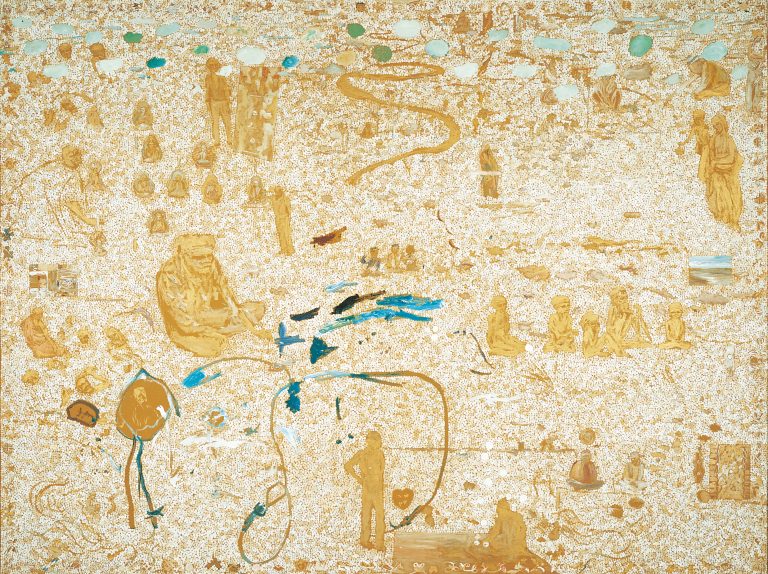We acknowledge the Traditional Owners of the land on which the Queensland Art Gallery | Gallery of Modern Art stands and recognise the creative contribution First Australians make to the art and culture of this country.

Tim Johnson / Australia b.1947 / Yuelamu 1988 / Synthetic polymer paint on canvas 183 x 242.2cm / Purchased 1988 / Collection: Queensland Art Gallery / © The artist
Tim JohnsonYuelamu 1988
Not Currently on Display
Throughout the 1980s, Tim Johnson explored the spaces between the great narrative traditions of Tibetan, Chinese, Aboriginal and native American cultures. This work, Yuelamu 1988, stems from this period.
Yuelamu is the name of a community in the Northern Territory, near the thriving town of Yuendumu — a place that was key to the emergence of contemporary Aboriginal art.
Since the end of the 1970s, Johnson has been a regular visitor to the central western desert of Australia and, over time, has developed a strong relationship with the Walpiri and Pintupi peoples at Papunya. From this association, Johnson has developed an intricately woven painting practice, drawing on the visual conventions of many distinct cultures. In doing so, Johnson looks for commonalities between non-Aboriginal and Aboriginal cultures.
Tim Johnson was born in Sydney in 1947. In 1966, he enrolled in a Bachelor of Arts course at the University of New South Wales. During his time at university, he painted obsessively and interviewed artists whose work interested him.
His first solo exhibition in 1969 was followed by another solo show, ‘Off the Wall’, at Sydney’s Gallery A. In the 1970s, he moved away from painting, creating conceptual and performance works, experimenting with whatever materials were at hand.
Johnson supported the entry of Aboriginal artists into the wider arena of contemporary Australian art, and painters from Papunya and other key Aboriginal painting centres had a profound influence on his work.
Tim and his then wife Vivien Johnson made a significant contribution to the process of bringing Western Desert painting to wider attention, which culminated in the explosion of interest in the 1980s from the art community and the commercial art market for these artists and their work.
In tribute to the brilliance of Aboriginal painting, and as part of his project of cross-cultural dialogue, Johnson’s work often employs the Western Desert dot technique, although it avoids the use of Aboriginal designs, which are specific to particular dreaming stories and which only certain Aboriginal artists have the right to use.
Johnson’s involvement with Aboriginal culture has led him to inquire into other non-Western art histories. In the 1990s he began to see Australia as part of Asia instead of Europe, and examined Tibetan art and Buddhism, as well as Chinese and other Asian art traditions.
Endnotes:
Julie Ewington and Wayne Tunnicliffe, ‘Introducing Tim Johnson’, in Tim Johnson: Painting Ideas [exhibition catalogue], Queensland Art Gallery, Brisbane, 2009, pp.9–10.
‘Tim Johnson’, Dominik Mersch Gallery.